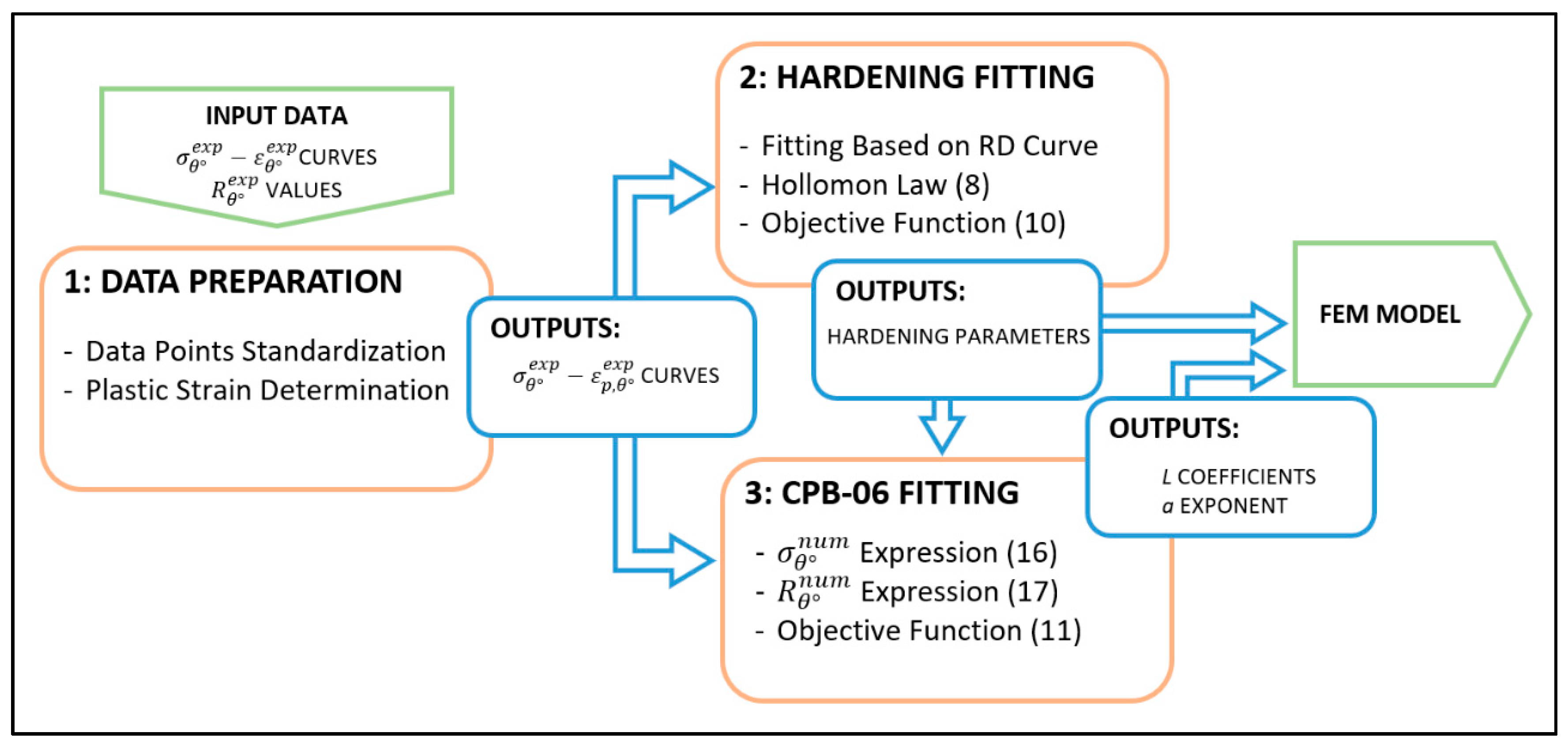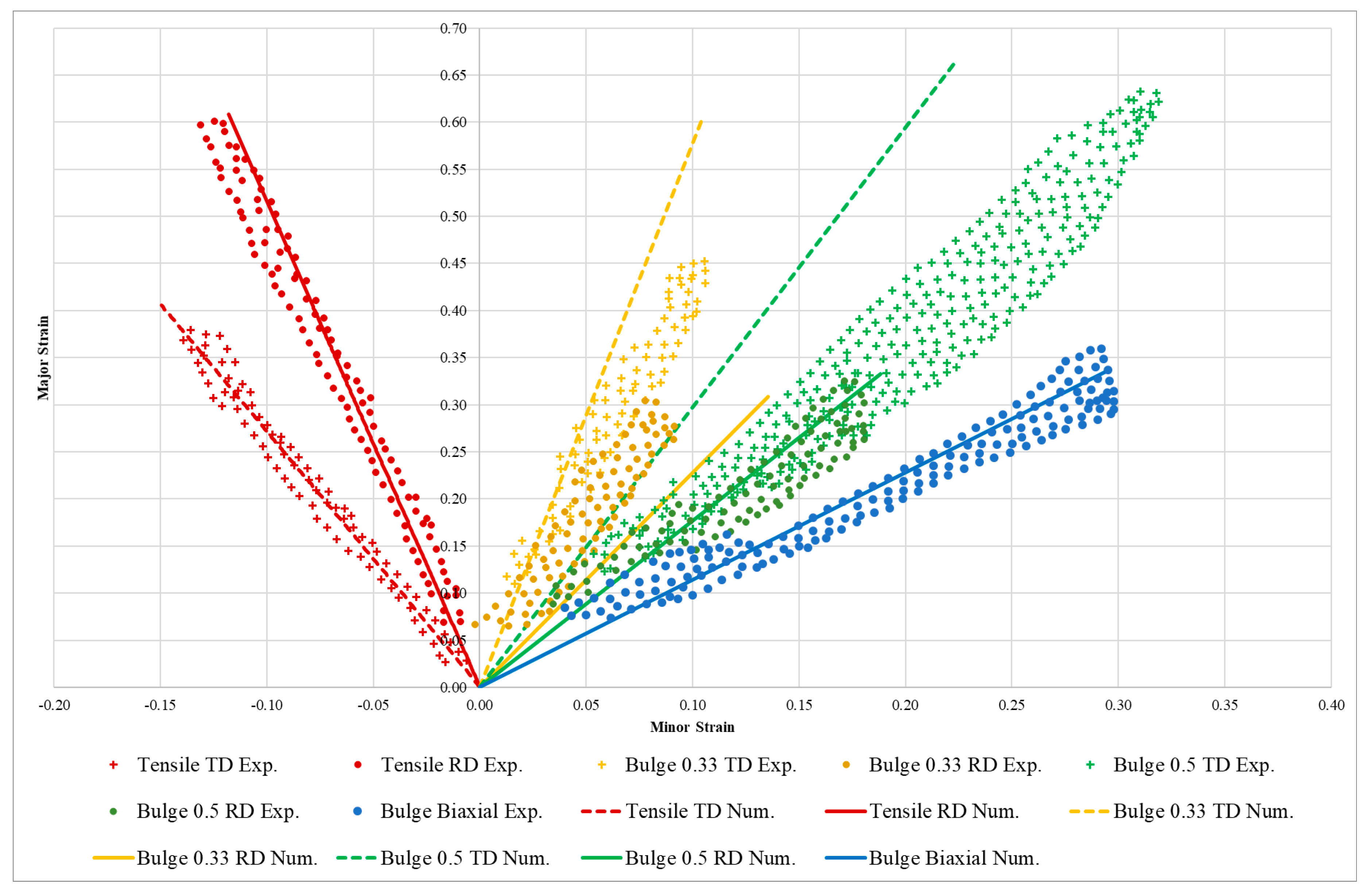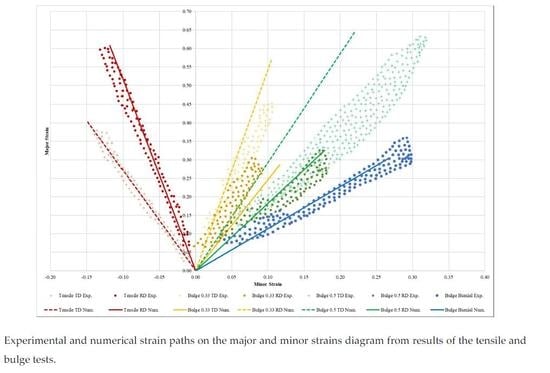Characterization of the Elastoplastic Response of Low Zn-Cu-Ti Alloy Sheets Using the CPB-06 Criterion
Abstract
1. Introduction
2. Materials and Methods
2.1. Material
2.2. CPB-06/Hollomon Elastoplastic Model
2.3. Fitting Procedure via the Tensile Test
2.3.1. Data Preparation
2.3.2. Hardening Fitting
2.3.3. CPB-06 Fitting
2.4. Numerical Simulations of the Bulge Test
3. Results
3.1. Fitting Procedure
3.2. Bulge Test
4. Discussion
5. Conclusions
Author Contributions
Funding
Acknowledgments
Conflicts of Interest
References
- Jansen, Y.; Logé, R.; Milesi, M.; Massoni, E. An anisotropic stress based criterion to predict the formability and the fracture mechanism of textured zinc sheets. J. Mater. Process. Technol. 2013, 213, 851–855. [Google Scholar] [CrossRef]
- Zhang, F.; Vincent, G.; Sha, Y.H.; Zuo, L.; Fundenberger, J.J.; Esling, C. Experimental and simulation textures in an asymmetrically rolled zinc alloy sheet. Scr. Mater. 2004, 50, 1011–1015. [Google Scholar] [CrossRef]
- Pantazopoulos, G.; Vazdirvanidis, A.; Rikos, A.; Toulfatzis, A. Failure investigation of cold-rolled ZnTiCu alloy fracture during bending under ambient temperature conditions. J. Fail. Anal. Prev. 2013, 13, 757–764. [Google Scholar] [CrossRef]
- Pantazopoulos, G.; Toulfatzis, A.; Vazdirvanidis, A.; Rikos, A. Fundamental aspects of rolled Zn alloy sheet formability: Structure-property and failure mode relationships. Mater. Sci. Forum 2017, 879, 1443–1448. [Google Scholar] [CrossRef]
- Milesi, M.; Logé, R.; Muñoz, D.P.; Jansen, Y.; Bouchard, P.O. Accounting for material parameters scattering in rolled zinc formability. J. Mater. Process. Technol. 2017, 245, 134–148. [Google Scholar] [CrossRef]
- Schlosser, F.; Schwindt, C.; Fuster, V.; Tommasi, A.; Signorelli, J.W. Crystallographic Texture Evolution of a Zinc Sheet Subjected to Different Strain Paths. Metall. Mater. Trans. A Phys. Metall. Mater. Sci. 2017, 48, 2858–2867. [Google Scholar] [CrossRef]
- Milesi, M.; Logé, R.; Jansen, Y. Anisotropic mechanical behavior and formability criterion for zinc sheets. J. Mater. Process. Technol. 2014, 214, 2869–2876. [Google Scholar] [CrossRef]
- Philippe, M.J.; Fundenberger, J.J.; Galledou, Y.; Humbert, M.; Wegria, J.; Esling, C. Influence of Texture on Low Temperature Bendability of Zn Alloys. Textures Stress Microstruct. 1991, 14, 471–476. [Google Scholar] [CrossRef]
- Philippe, M.J.; Wagner, F.; Mellab, C.; Esling, C.; Wegria, J. Modelling of Texture Evolution for Materials of Hexagonal Symmetry—I. Application to Zinc Alloys. Acta Metall. Mater. 1994, 42, 239–250. [Google Scholar] [CrossRef]
- Hosford, W.; Allen, T.J. Twinning and directional slip as a cause for a strength differential effect. Metall. Trans. 1973, 4, 1424–1425. [Google Scholar] [CrossRef]
- Delannay, L.; Logé, R.; Signorelli, J.W.; Chastel, Y. Prediction of the planar anisotropy of springback after bending of a textured zinc sheet. AIP Conf. Proc. 2004, 712, 1058–1063. [Google Scholar]
- Schwindt, C.; Schlosser, F.; Bertinetti, M.A.; Stout, M.; Signorelli, J.W. Experimental and Visco-Plastic Self-Consistent evaluation of forming limit diagrams for anisotropic sheet metals: An efficient and robust implementation of the M-K model. Int. J. Plast. 2015, 73, 62–99. [Google Scholar] [CrossRef]
- Banabic, D.; Barlat, F.; Cazacu, O.; Kuwabara, T. Advances in anisotropy and formability. Int. J. Mater. Form. 2010, 3, 165–189. [Google Scholar] [CrossRef]
- Jansen, Y.; Logé, R.; Milesi, M.; Manov, S.; Massoni, E. Theoretical and Experimental Evaluation of the Formability of Anisotropic Zinc Sheets. In Key Engineering Materials; Trans Tech Publications Ltd.: Zürich, Switzerland, 2011; Volume 473, pp. 390–395. [Google Scholar]
- Jansen, Y.; Logé, R.; Manach, P.Y.; Carbuccia, G.; Milesi, M. On the benefits of a stress criterion for the simulation of cup drawing process. Int. J. Mater. Form. 2017, 10, 707–716. [Google Scholar] [CrossRef]
- Jansen, Y.; Logé, R.; Milesi, M.; Manov, S.; Massoni, E. Using Cross Stamping to Test Zinc Sheets Formability. In Key Engineering Materials; Trans Tech Publications Ltd.: Zürich, Switzerland, 2012; Volume 504, pp. 65–70. [Google Scholar]
- Milesi, M.; Chastel, Y.; Hachem, E.; Bernacki, M.; Logé, R.E.; Bouchard, P.O. A multi-scale approach for high cycle anisotropic fatigue resistance: Application to forged components. Mater. Sci. Eng. A 2010, 527, 4654–4663. [Google Scholar] [CrossRef]
- Li, H.; Hu, X.; Yang, H.; Li, L. Anisotropic and asymmetrical yielding and its distorted evolution: Modeling and applications. Int. J. Plast. 2015, 82, 127–158. [Google Scholar] [CrossRef]
- Plunkett, B.; Lebensohn, R.A.; Cazacu, O.; Barlat, F. Anisotropic yield function of hexagonal materials taking into account texture development and anisotropic hardening. Acta Mater. 2006, 54, 4159–4169. [Google Scholar] [CrossRef]
- Cazacu, O.; Plunkett, B.; Barlat, F. Orthotropic yield criterion for hexagonal closed packed metals. Int. J. Plast. 2006, 22, 1171–1194. [Google Scholar] [CrossRef]
- Barlat, F.; Maeda, Y.; Chung, K.; Yanagawa, M.; Brem, J.C.; Hayashida, Y.; Lege, D.J.; Matsui, K.; Murtha, S.J.; Hattori, S.; et al. Yield function development for aluminum alloy sheets. J. Mech. Phys. Solids 1997, 45, 1727–1763. [Google Scholar] [CrossRef]
- Barlat, F.; Aretz, H.; Yoon, J.W.; Karabin, M.E.; Brem, J.C.; Dick, R.E. Linear transfomation-based anisotropic yield functions. Int. J. Plast. 2005, 21, 1009–1039. [Google Scholar] [CrossRef]
- Cazacu, O.; Ionescu, I.R.; Yoon, J.W. Orthotropic strain rate potential for the description of anisotropy in tension and compression of metals. Int. J. Plast. 2010, 26, 887–904. [Google Scholar] [CrossRef]
- Chandola, N.; Lebensohn, R.A.; Cazacu, O.; Revil-Baudard, B.; Mishra, R.K.; Barlat, F. Combined effects of anisotropy and tension-compression asymmetry on the torsional response of AZ31 Mg. Int. J. Solids Struct. 2015, 58, 190–200. [Google Scholar] [CrossRef]
- Revil-Baudard, B.; Chandola, N.; Cazacu, O.; Barlat, F. Correlation between swift effects and tension-compression asymmetry in various polycrystalline materials. J. Mech. Phys. Solids 2014, 70, 104–115. [Google Scholar] [CrossRef]
- Yoon, J.H.; Cazacu, O.; Mishra, R.K. Constitutive modeling of AZ31 sheet alloy with application to axial crushing. Mater. Sci. Eng. A 2013, 565, 203–212. [Google Scholar] [CrossRef]
- Tuninetti, V.; Gilles, G.; Péron-lührs, V.; Habraken, A.M. Compression test for metal characterization using digital image correlation and inverse modeling. Procedia IUTAM 2012, 4, 206–214. [Google Scholar] [CrossRef]
- Tuninetti, V.; Gilles, G.; Milis, O.; Pardoen, T.; Habraken, A.M. Anisotropy and tension-compression asymmetry modeling of the room temperature plastic response of Ti-6Al-4V. Int. J. Plast. 2015, 67, 53–68. [Google Scholar] [CrossRef]
- Muhammad, W.; Mohammadi, M.; Kang, J.; Mishra, R.K.; Inal, K. An elasto-plastic constitutive model for evolving asymmetric/anisotropic hardening behavior of AZ31B and ZEK100 magnesium alloy sheets considering monotonic and reverse loading paths. Int. J. Plast. 2015, 70, 30–59. [Google Scholar] [CrossRef]
- Tromans, D. Elastic Anisotropy of HCP Metal Crystals and Polycrystals. Int. J. Res. Rev. Appl. Sci. 2011, 6, 462–483. [Google Scholar]
- Celentano, D.; Guelorget, B.; Francois, M.; Cruchaga, M.; Slimane, A. Numerical simulation and experimental validation of the microindentation test applied to bulk elastoplastic materials. Model. Simul. Mater. Sci. Eng. 2012, 20, 196–198. [Google Scholar] [CrossRef]
- Leonard, M.; Nicoletti, E.; Roatta, A.; Stout, M.; Signorelli, J.W. Estudio de la Anisotropía mecánica en chapas de zinc y su relación con la textura cristalográfica. Rev. LatinAm. Metal. Mat. 2019, S8, 43–47. [Google Scholar]
- Barros, P.D.; Alves, J.L.; Oliveira, M.C.; Menezes, L.F. Modeling of tension-compression asymmetry and orthotropy on metallic materials: Numerical implementation and validation. Int. J. Mech. Sci. 2016, 114, 217–232. [Google Scholar] [CrossRef]
- Safaei, M.; Lee, M.G.; Zang, S.L.; de Waele, W. An evolutionary anisotropic model for sheet metals based on non-associated flow rule approach. Comput. Mater. Sci. 2014, 81, 15–29. [Google Scholar] [CrossRef]
- Stoughton, T.B.; Yoon, J.W. Anisotropic hardening and non-associated flow in proportional loading of sheet metals. Int. J. Plast. 2009, 25, 1777–1817. [Google Scholar] [CrossRef]
- Oya, T.; Yanagimoto, J.; Ito, K.; Uemura, G.; Mori, N. Material model based on non-associated flow rule with higherorder yield function for anisotropic metals. Procedia Eng. 2014, 81, 1210–1215. [Google Scholar] [CrossRef][Green Version]
- Bouchard, P.O.; Bourgeon, L.; Fayolle, S.; Mocellin, K. An enhanced Lemaitre model formulation for materials processing damage computation. Int. J. Mater. Form. 2011, 4, 299–315. [Google Scholar] [CrossRef]
- Cao, T.S.; Gachet, J.M.; Montmitonnet, P.; Bouchard, P.O. A Lode-dependent enhanced Lemaitre model for ductile fracture prediction at low stress triaxiality. Eng. Fract. Mech. 2014, 124, 80–96. [Google Scholar] [CrossRef]
- Peerlings, R.; de Borst, R.; Brekelmans, W.; de Vree, J.; Spee, I. Some observations on localisation in non-local and gradient damage models. Eur. J. Mech. A/Solids 1996, 15, 937–953. [Google Scholar]






| Parameter | RD | DD | TD |
|---|---|---|---|
| (MPa) | 99.6 | 110.0 | 122.0 |
| 0.25 | 0.35 | 0.60 |
| K (MPa) | ||
|---|---|---|
| 171.38 | 0.363 | 0.538 |
| L12 | L14 | L22 | L24 | L33 | L44 | a |
|---|---|---|---|---|---|---|
| 0.1011 | −0.2115 | 0.9141 | −0.0156 | 0.8408 | 1.0346 | 6.0 |
| 0.25 | 0.35 | 0.60 | |
| Relative Error (%) | 0.12 | 0.23 | 0.12 |
| RD | |||
|---|---|---|---|
| 4.061 | 2.775 | 1.914 | |
| 0.000 | 0.001 | 0.000 |
© 2019 by the authors. Licensee MDPI, Basel, Switzerland. This article is an open access article distributed under the terms and conditions of the Creative Commons Attribution (CC BY) license (http://creativecommons.org/licenses/by/4.0/).
Share and Cite
Alister, F.; Celentano, D.; Signorelli, J.; Bouchard, P.-O.; Pino, D.; Cruchaga, M. Characterization of the Elastoplastic Response of Low Zn-Cu-Ti Alloy Sheets Using the CPB-06 Criterion. Materials 2019, 12, 3072. https://doi.org/10.3390/ma12193072
Alister F, Celentano D, Signorelli J, Bouchard P-O, Pino D, Cruchaga M. Characterization of the Elastoplastic Response of Low Zn-Cu-Ti Alloy Sheets Using the CPB-06 Criterion. Materials. 2019; 12(19):3072. https://doi.org/10.3390/ma12193072
Chicago/Turabian StyleAlister, Francisco, Diego Celentano, Javier Signorelli, Pierre-Olivier Bouchard, Daniel Pino, and Marcela Cruchaga. 2019. "Characterization of the Elastoplastic Response of Low Zn-Cu-Ti Alloy Sheets Using the CPB-06 Criterion" Materials 12, no. 19: 3072. https://doi.org/10.3390/ma12193072
APA StyleAlister, F., Celentano, D., Signorelli, J., Bouchard, P.-O., Pino, D., & Cruchaga, M. (2019). Characterization of the Elastoplastic Response of Low Zn-Cu-Ti Alloy Sheets Using the CPB-06 Criterion. Materials, 12(19), 3072. https://doi.org/10.3390/ma12193072








